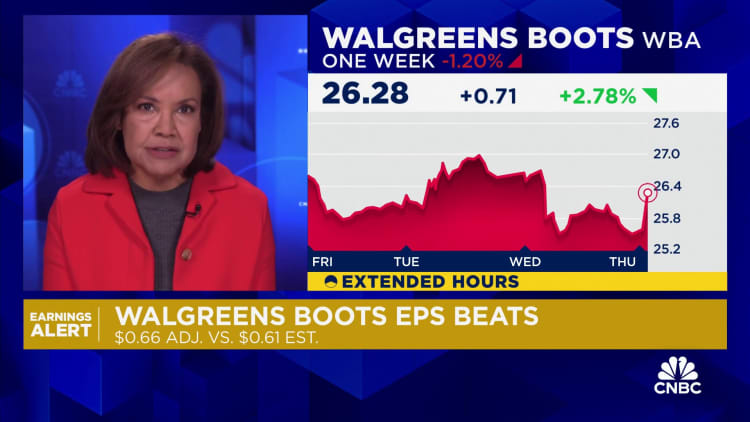[ad_1]

Shares of Walgreens closed 5% lower on Thursday after the company reported fiscal first-quarter adjusted earnings and revenue that topped expectations, but cut its quarterly dividend nearly in half.
The retail pharmacy giant slashed its dividend to 25 cents per share from 48 cents per share to “strengthen [its] long-term balance sheet and cash position,” CEO Tim Wentworth, who officially took the helm during the quarter, said in a statement.
Walgreens’ dividend yield is now 3.9%, based on Wednesday’s closing price. That’s down significantly from its prior yield of more than 7%, which made the company the highest-paying dividend stock in the Dow Jones Industrial Average.
It also marks the company’s first dividend cut in nearly five decades. The dividend will be payable on March 12.
In an interview with CNBC, Wentworth called the dividend cut an “incredibly important and responsible” decision.
He added that the majority of investors expected the move and “actually are excited about the fact that we’re going to have additional capital to invest in the core business in a way that stimulates growth again, because that ultimately is going to be the most shareholder-friendly thing we can do.”

The dividend reduction comes as Wentworth, a health-care industry veteran, tries to steer the company out of a rough spot.
Shares of Walgreens plummeted 30% last year as the company grappled with weakening demand for Covid products, low pharmacy reimbursement rates, increased pressure from online retailers, labor unrest among pharmacy staff in the fall, an uneven push into health care and a challenging macroeconomic environment.
But Thursday’s earnings beat marks a turnaround from October, when Walgreens missed earnings estimates for two straight quarters for the first time in nearly a decade.
Here’s what Walgreens reported for the three-month period ended Nov. 30 compared with what Wall Street was expecting, based on a survey of analysts by LSEG, formerly known as Refinitiv:
- Earnings per share: 66 cents per share adjusted vs. 61 cents expected
- Revenue: $36.71 billion vs. $34.86 billion expected
The company reported a net loss of $67 million, or 8 cents per share, for the fiscal first quarter.
That compares with a net loss of $3.7 billion, or $4.31 per share, during the same period a year ago, when Walgreens was ordered to pay a multibillion-dollar settlement for litigation alleging the company helped fuel the nation’s opioid crisis.
The net loss in the most recent quarter included a $278 million after-tax charge related to Walgreens’ forward sale of shares of drug distributor Cencora, formerly known as AmerisourceBergen.
Excluding certain items, adjusted earnings per share were 66 cents for the fiscal first quarter.
Walgreens booked sales of $36.71 billion in the quarter, a roughly 10% jump from the same period a year ago.
The company said revenue growth in its U.S. retail pharmacy and international business segments, and sales contributions from its U.S. health-care division, drove the increase. Walgreens is making significant investments to transform from a major drugstore chain to a large health-care company.
Despite the quarterly beats, Walgreens reiterated its fiscal 2024 adjusted earnings guidance of $3.20 to $3.50 per share.
Executives during an earnings call Thursday highlighted incremental fiscal year 2024 “tailwinds and headwinds in a challenging environment” compared to when it issued its previous outlook.
Walgreens now expects better performance from its pharmacy services unit due to more favorable tax rates. It forecast a full-year adjusted effective tax rate of 15% to 17%, compared to the prior outlook of 19% to 20%.
But executives also expect several hurdles, including lower market growth in prescriptions and lower sale and leaseback contributions. They also expect a pullback in consumer spending to cut into U.S. retail sales in the short term, then improve in the second half of the fiscal year.
The company did not indicate in the earnings release whether it would also maintain its previous revenue guidance of $141 billion to $145 billion.
During an earnings call on Thursday, executives said the company is on track to achieve $1 billion in cost savings during fiscal 2024 due to its ongoing cost-cutting initiative, which involves closing unprofitable stores, layoffs and using artificial intelligence to drive supply chain efficiencies, among other efforts.
Sales growth across pharmacy and health care
Walgreens’ U.S. retail pharmacy segment generated $28.94 billion in sales in the fiscal first quarter, an increase of more than 6% from the same period last year. Comparable sales at pharmacy locations rose 8.1%.
That segment operates more than 8,000 drugstores across the U.S., which sell prescription and nonprescription drugs as well as health and wellness, beauty, personal care, and food products.
A customer prepares to enter a Walgreens store on October 31, 2023 in Los Angeles, California. Pharmacy staff at some CVS and Walgreens locations have organized a three day walkout in multiple states which will last until November 1.
Mario Tama | Getty Images
Pharmacy sales for the quarter rose 10.7% compared with the fiscal first quarter of 2023, as comparable sales climbed more than 13% due to price inflation in brand medications and “strong execution” in pharmacy services, Walgreens said.
Total prescriptions filled in the quarter including immunizations totaled 311.6 million, which is flat compared with the same period a year ago.
Walgreens cited a weaker respiratory virus season this fall, which is blunting demand for medications and vaccines. The company also pointed to Medicaid redeterminations, which are routine reviews each state’s Medicaid agency conducts to determine whether beneficiaries still qualify for coverage.
Retail sales for the quarter fell 6.1% from the same period a year ago, and comparable retail sales declined 5%. Walgreens pointed to the weaker respiratory season as well as “macroeconomic-driven consumer trends” and Thanksgiving holiday store closures – a first for the company last year — to explain the decrease.
Meanwhile, the company’s international segment, which operates more than 3,000 retail stores abroad, racked up $5.83 billion in sales in the fiscal first quarter. That’s a rise of more than 12% from the same period a year ago.
The company said sales from Walgreens’ U.K. subsidiary, Boots, grew more than 6%.
Revenue from Walgreens’ U.S. health-care segment came in at $1.93 billion, up from $989 million in the same period last year.
That increase reflects primary-care provider VillageMD’s acquisition of multi-specialty care provider Summit Health and growth across all businesses in the segment on a pro forma basis.
VillageMD sales grew 14% compared to the same period a year ago due to same-clinic growth and strength in Summit Health, among other factors.
Sales from the segment’s specialty pharmacy company, Shields Health Solutions, grew 27%, driven by recent contract wins with health systems and expansion of existing partnerships.
Specialty pharmacies are designed to deliver medications with unique handling, storage and distribution requirements, often for patients with complex conditions such as cancer and rheumatoid arthritis.
— CNBC’s Bertha Coombs and Robert Hum contributed to this report.
Don’t miss these stories from CNBC PRO:
Clarification: This story was updated to reflect that Summit Health is a multi-specialty care provider.
[ad_2]
Source link



